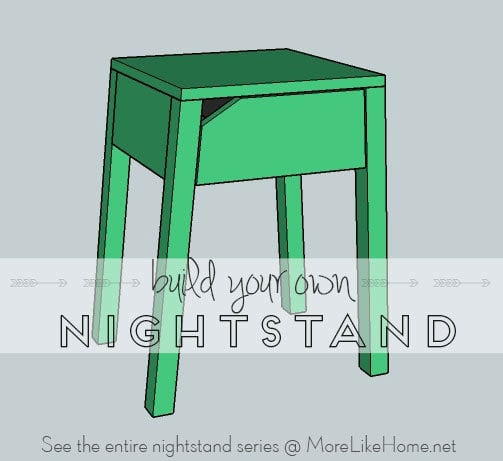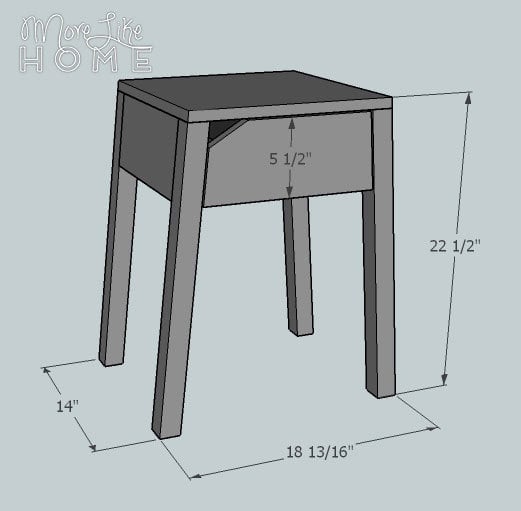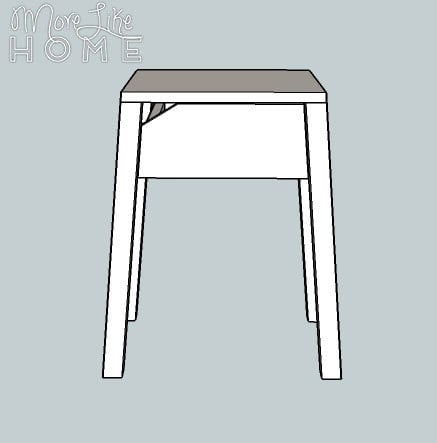
This nightstand has a notch in a the drawer that you can pull a cord through for easy tabletop charging! Plus the notch doubles as drawer pull (no knobs needed!) to keep it looking sleek and simple. Get the plans at More Like Home: http://www.morelikehome.net/2015/03/nightstands-day-4-built-in-charging…

Preparation
1 - 2x2 @ 8'
1 - 1x6 @ 4' (or two 11" scraps)
1 - 1x4 @ 8'
1 - 1x2 @ 4'
1 - 1x12 @ 10" (you'll probably have to buy a full 4' board unless you have a scrap)
12" drawer slides
wood filler
wood glue
1 1/4" screws
2" screws
Kreg Jig with 1 1/4" and 2 1/2" pocket screws (optional)
finishing nails
(A) 4 - 2x2 @ 22" (legs)
(B) 1 - 1x6 @ 13" (back)
(C) 2 - 1x6 @ 11" (sides)
(D) 2 - 1x2 @ 11" (drawer supports)
(E) 4 - 1x4 @ 15" (top)
(F) 1 - 1x12 @ 10" (drawer bottom)
(G) 1 - 1x4 @ 10" (drawer back)
(H) 2 - 1x4 @ 12" (drawer sides)
(I) 1 - 1x4 @ 12 3/4" (drawer front)
Please read through the entire plan and all comments before beginning this project. It is also advisable to review the Getting Started Section. Take all necessary precautions to build safely and smartly. Work on a clean level surface, free of imperfections or debris. Always use straight boards. Check for square after each step. Always predrill holes before attaching with screws. Use glue with finish nails for a stronger hold. Wipe excess glue off bare wood for stained projects, as dried glue will not take stain. Be safe, have fun, and ask for help if you need it. Good luck!
Instructions
Step 1
Step 2
Prepare the back board (B) by cutting each side at a 5 degree angle as shown below. The bottom edge should stay 13" wide and the top will now be slightly narrower. If you want to run a charging cord or power strip into the drawer (you can pull it out through the notch in the drawer front for charging) make a hole near the top of the back board. You can use a large drill bit (make sure whatever cord you use will fit through, probably 1 - 1.5") or use a reciprocating saw to cut a notch out.
Step 3
Step 4
Attach the sides (C). You don't need to taper the top edge since it will be hidden in the end. Just line up the outside edges and top corner flush. Attach the sides using good old Kreg, or by drilling through the legs into the side boards (careful not to hit the screw holding the back).
Step 5
Attach a front leg (A) to each side. Line up the top corners and outside edges flush (again make sure the leg tapers point out to the sides). Attach with a Kreg Jig or by drilling through the legs into the sides.
Step 6
Install the drawer supports (D). They should be 1/2" above the bottom edge of the side boards. It's important to install these vertically (not at an angle like the sides) so your drawer slides will work properly, so use a level. Set the top right against the side of the table, then swing the bottom out a little until it is perfectly level. Attach using a Kreg Jig or by drilling through the supports into the side boards (but be careful not to let the board go out of level. It may help to add a shim to keep it in place. Double check the width between the support before building your drawer box! The finished drawer should be 1" smaller than the space.
Step 7
Attach the top (E). Ignore the top in the previous photo. :) Cut the end of each top board at a 5 degree angle (like this /=\). Double check the measurements first, you want a good fit here. You can use a Kreg Jig to attach the boards together side by side first, or just attach each one to the table individually. Make sure the table is square as you go. Attach the boards using glue and finishing nails.
Step 8
Step 9
Step 10
It is always recommended to apply a test coat on a hidden area or scrap piece to ensure color evenness and adhesion. Use primer or wood conditioner as needed.













